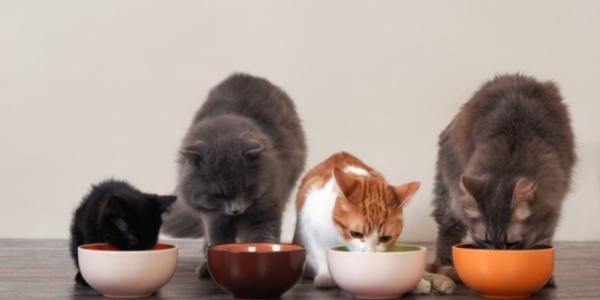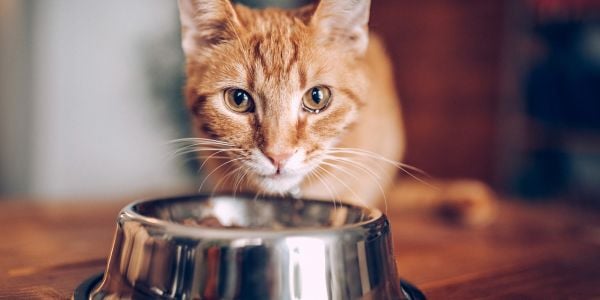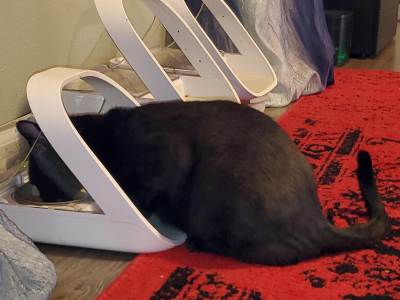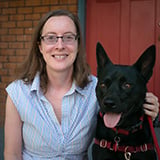 If you have been researching on the internet, talking with friends, or even with your veterinarian, everyone has an opinion on whether dry food or wet food is better for cats.
If you have been researching on the internet, talking with friends, or even with your veterinarian, everyone has an opinion on whether dry food or wet food is better for cats.
When I started out as a vet student, the opinion was that dry food was better for preventing dental disease. Then, veterinary opinion switched to wet food for its higher protein and moisture content, and urinary health benefits.
Is one really better than the other?
Skip to section:
The Facts About Wet and Dry Food for Cats
-
Dry foods contain 6–10% water, while wet foods contain, on average, 75% water.
-
Wet foods are easier to digest than dry diets.
-
Because wet food is mostly water, it costs more per calorie and takes up more storage space.
-
Wet food has a long shelf life. However, once wet food has been opened, it must be kept in the refrigerator and used within 3–5 days. If your cat does not eat wet food after 4 hours, it is safest to throw it out.
-
Dry diets are little kibbles full of calories! Dry diets are 3–4 kcal/g vs. wet food’s 0.8–1.5 kcal/g. A cat has to eat just 1/3 cup of dry food to get the same number of calories in 1 cup of wet food, making dry food a good value.
-
Compared to wet foods, dry foods tend to have more carbohydrates than wet foods because starches are necessary for cooking the kibbles.
-
Dry food can be left out for longer periods if the bowl is clean, away from sunlight, and protected from insects and rodents.
BOWL TIP: To protect against stomach upset and dental disease, wash your cat’s dry food and water bowls daily. Wash wet food bowls before each meal.
- Depending on the manufacturer, dry food bags should be replaced after 2–3 months once they are opened. Unopened bags should have a “Best By” or expiration date. Most unopened bags have a shelf life of 1.5–3 years as long as they are kept at the recommended temperature range.
STORAGE TIP: If you store your dry food in a container, keep it in its bag! This helps to the food from going rancid and helps to prevent mold growth. Roll the top of the bag to let out any air inside, and clip the bag closed. Place the bag in an airtight container to keep out any moisture and air.
This also allows you to have the UPC code for the food in case it is recalled.
Which Cats Would Benefit from Wet Food?
1. Cats with these medical conditions are prone to dehydration or need dilute urine:
-
Feline interstitial cystitis
2. Cats who need food that is easy to digest AND increased hydration
Cats suffering from frequent vomiting or diarrhea, for example:-
Kittens with infectious diarrhea
-
Inflammatory bowel disease
-
Gastrointestinal lymphoma
-
Cats on chemotherapy
3. Overweight cats who need to lose weight
Cats lose weight more readily on a wet diet. Because wet diets are primarily water, a cat must eat a larger amount of food by weight to get the same number of calories. Also, since wet food cannot sit out, so we have the opportunity to feed smaller meals more frequently, which cats prefer.
The nice thing about wet food is that it comes in distinct sizes that we must measure out multiple times a day. If an overweight cat is fed only wet food, we know exactly how much our cat eats.

In vet school, I had a " fatty cat” named Cannon (in the photos above), who was highly resistant to exercise. I started to feed him in a spot on the opposite side of the house from where he would sleep all day. Three times a day, Cannon’s only exercise was “running” for his food and then another time before bed for a tiny treat. Over 2.5 years, he lost 3 pounds!
4. Cats with painful mouths appreciate wet food
Cats who may have a painful mouth due to dental disease, stomatitis, a mass in their mouth, or an infection may stop eating if it hurts to chew. Softer food might help them eat with more comfort.
It may take some trial and error to determine which diet is easiest for your kitty. Often, pâté styles work best. Your veterinarian may recommend a higher-calorie prescription food if your kitty is losing weight or not eating well.
5. Picky eaters or ill cats
Wet food often smells more appealing than dry food, and the smell often appeals to cats, tempting them to eat.
If you have a cat who is very picky or who is not feeling well, it is easiest to buy several cans of wet food rather than several small bags of dry food.
If your cat is not eating much at all, reach out to your veterinarian to ensure that there is no underlying medical condition and discuss how you can best get your cat eating normally again.
Here is a calorie calculator if you don’t know how much your cat should be eating.
6. For medicating cats
I don’t recommend adding most medications to your cat’s food because they generally taste bad and will cause your cat to stop eating. See this article for tips on pilling your cat.
However, there are a few tasty supplements that are available to add to wet food, such as the Fortiflora and Calming Care probiotics and Cosequin Sprinkle Caps for joint health. Fortiflora and Calming Care are tasty enough to get some very picky cats to eat even when they don’t feel well.
7. Cats who vomit after eating too fast
If you have a cat who loves wet food but vomits after eating too quickly, a lick mat can slow your cat down and may help prevent that vomiting.

Which Cats Would Benefit from Dry Food?
Dental Benefits
There is mixed evidence about whether regular dry food prevents dental tartar. However, there is good evidence that specific dental diets, like Science Diet Oral Care Adult, do help prevent tartar and plaque accumulation on teeth because as cats chew the extra-large kibbles, the pieces rub against the teeth and help break up tartar. The kibbles also contain an anti-plaque nutrient to prevent plaque from forming. These diets work best on a clean mouth, so they are best for young kitties and after your adult cat has had a dental cleaning.
Dental treats and water additives can also help keep your cat’s teeth and gums healthy. We have some vet-recommended dental products here, and you can find more information on the Veterinary Oral Health Council’s Recommended Products for Cats.

Grazers
Dry food is perfect for your slow-eating grazers who like to free-feed all day. Even though you're free-feeding, you still need to measure your cat's food so as not to encourage over-eating. Many cats are overweight because they're left with an unmeasured amount of food to graze on all day.
If you have multiple cats who overeat (i.e., steal each other's food) or with different diet needs, feeding one dry diet becomes impossible. When this happened in my household, we first took the low-tech route by feeding the three cats three times a day in three different rooms for eight years until our food-allergic cat passed on. When we had another cat who needed feeding separately, we used SureFlap feeders successfully. Check out Etsy for after-market SureFlap feeders and accessories if you have cats who try to steal another’s food from the side or back.
On this note, if you are feeding multiple cats with dry food, take care to ensure that all cats are getting enough to eat. Sometimes a bully prevents other cats from getting their fair share. If you are not home to watch what is going on, a camera to watch their activities could be helpful.
Underweight Cats
Underweight cats can gain weight more easily by eating dry food because the kibbles are so calorie-dense.
SAVE MONEY: With dry diets, you get more food for your money. If you are feeding lots of cats, you can buy a large bag, which does not take up a whole room compared to the same amount of calories of wet food.
Feral Cats
If you are feeding outdoor/feral cats, consider feeding an “All Life Stages” diet. This means that the diet can be fed to growing cats, pregnant and nursing cats, and adult cats. For growing, pregnant, and nursing cats, this diet provides extra protein, phosphorus, and calcium that regular adult diets do not provide.
If you do have some outdoor kitties who need to be spayed or neutered, here is information from Alley Cat Allies on Trap-Neuter Return programs.
One of the greatest benefits of dry food is its flexibility.
- Automatic feeders
- Slow feeders – for cats who tend to eat their food too quickly
- Food Puzzles
- Snuffle Mats
- Hunting Toys
- Rewards for training
Try tunnel feeders, slow feeders, or other interactive feeders.
Why I Recommend Feeding Kittens Both Wet and Dry Food?
I always recommend introducing both wet and dry foods to kittens because I want these little ones to learn early the tastes and textures of new foods.
We don’t know what will happen to these kittens in the future, but chances are they will be sick one day. Illness often brings a poor appetite and weight loss, and we may have to introduce some new foods. If they have tasted both wet and dry foods before, they will be more receptive to them later.
Once a kitten has been acclimated to both types of food, it is the cat and pet parent’s preference which type (or types) to choose, as long as the cat is healthy.

In my own household, my current cat is Luke Skywalker, featured above with his canine pal, Cleo. He has Feline Interstitial Cystitis, yet he refuses to eat a wet diet, even though that would be best to prevent recurrences of his health condition. We have compromised. He is on a prescription dry diet. I ensure that he has enough water with:
-
There are multiple ceramic water bowls throughout the house.
-
The water bowls are nowhere near his food (cats are fussy about that).
-
He receives treats of Hydra Care. This is a liver-flavored gravy-texture hydration supplement.
-
He has a water fountain, too.
As you can see, even as a veterinarian I can’t get my cat to eat wet food or dry food with water added. But he thinks Hydra Care is the best. We have a win there, at least!
While feeding both wet and dry to any cat is a great option, it does not have to be one or the other, as long as your cat receives enough calories and enough water.
I hope this summary about the choice between wet and dry cat food has been helpful to you and your kitties! Luke wants the Force to be with You!



